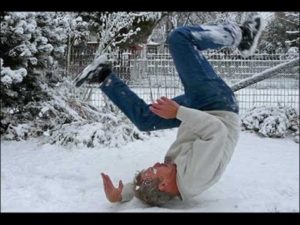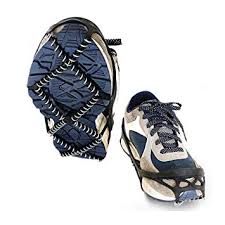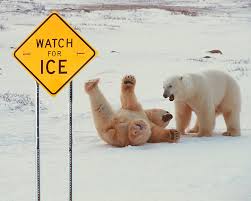
We have all been there; the wiggling from side to side, swaying in hopefully the right direction, trying to hold still to avoid the inevitable. You find your feet at a sheet of ice and you try all the tricks to avoid falling. Whether it is to avoid public embarrassment or injury, we have all played this dance one time or another. We may have some tips to help to avoid your next trip.
1. It is always a good idea to allow yourself extra time to arrive to your destination safely. Feeling rushed will not only distract you but also make you move quicker while unaware of your footing.
2. Walk slowly and carefully with steps shoulder width apart and take smaller steps to widen your base of support and maintain your center of gravity for better balance. Do not take shortcuts that may be unsafe or not treated, and never run on ice.
3. Be aware of your surroundings. Walkways or paths in shaded area should be avoided as these tend to refreeze the quickest, causing an unsafe area for walkers. Avoid areas that have been untreated or still consist of snow, and be cautious of black ice.

4. Choose suitable footwear if possible. Flat footwear with rubber soles tend to have better traction than leather soled or high heels. There are also ice grippers or traction cleats that you can purchase separate of your shoe. They are a rubber frame that slides over your shoe with metal traction material on the under side to give you better support for icy conditions.
5. Try to avoid carrying large or heavy items, make multiple trips or ask for help if available. If you are carrying a backpack or bag, carry it in front of your person to center it over your base of support and possibly cushion your fall.
6. Be careful getting in and out of vehicles or walking up or down on uneven surfaces/stairs. Use hand supports on vehicles and railings when possible. In these situations you are transferring your body weight to propel out of the car or descend down the path, so your balance is already compromised to stay upright or perform functionally.
7. Keep your hands out of your pockets and free for balance and an option to catch your fall. However, be careful with catching yourself with an open hand, many injuries can occur when trying to catch yourself.
8. Try to remain relaxed and exhale, rigidity causes muscles to tense causing increased damage to tissue. If agile enough, tuck and roll or pivot to your side, these can help save major injury to your extremities by offering a softer fall.
It is also a good idea to practice your balance regularly to increase stability and balance for situations beyond your control. Talk with your therapist at Premier Therapy for exercises and activities to work on. Lastly, if you do happen to get an injury, your friends at Premier Therapy can help you with recovery.

https://www.nytimes.com/2017/01/24/well/move/the-right-way-to-fall.html






